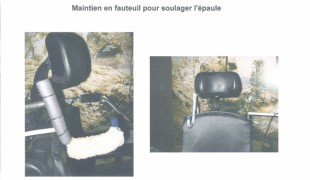- 5600
- 368
- 14
- 12
- 0
- Help Ukraine
About the solution
After working with young people suffering from mental and physical disabilities for nearly 20 years, Mario Vigentini invented a device to change their quality of life, the device raises up users so they are face-to-face with those standing.
Mario felt that this category of people was disheartened by the prejudice from others and he wanted to find a way to change the situation. “Trying to put an ergonomic seat -- like those from the Nordic countries that were very fashionable in the 1990s -- on a Segway," Mario said.
Mario was inspired by the Segway, the two-wheeled, self-balancing electric vehicle, and created the MarioWay. The device is and hands-free two-wheeled kneeling chair.
"Nine out of ten people I talked to about this idea looked at me as if I came from another planet," he said.
A team including disabled people, was set up to study the ergonomics involved. Users of traditional wheelchairs are seated so that "the organs in the upper part of the trunk are compressed", while "almost the whole weight rests on the ischium" -- the lower and back part of the hip bone.
This position "aggravates the pathologies of people with disabilities and results in other issues; digestive, respiratory, urinary or circulatory," he said, adding it also causes leg muscles to waste away. With MarioWay "the upper part of the trunk is straightened", strengthening muscles which go unused in traditional wheelchairs.
The chair can go up to 20km/h on a battery life of 30km.
The MarioWay allows users to do every day activities such as order a coffee and take a book from the high shelf. Mario said the aim was to create “a tool of social integration.”
The team is trying to lower the price of the chair by finding manufacturing partners. Mario hopes one day able-bodied people will use MarioWay too as mobility in cities will change.
Adapted from: https://www.ndtv.com/world-news/italian-wheelchair-marioway-hopes-to-bri...
More information: http://www.marioway.it/
https://www.youtube.com/watch?v=PUJsElUMHNQ
https://www.youtube.com/watch?v=PUJsElUMHNQ
This solution shall not include mention to the use of drugs, chemicals or biologicals (including food); invasive devices; offensive, commercial or inherently dangerous content. This solution was not medically validated. Proceed with caution! If you have any doubts, please consult with a health professional.
-
-
339
-
0
-
3367

Patient develops improved powerchairs
MOVING IN A WHEELCHAIR: Moving using a wheelchair.
BODY BALANCE: Maintaining body balance
Cerebral Palsy
Walking Aid (wheelchair/walker/crutches)
Assistive Daily Life Device (to help ADL)
Gait abnormalities (e.g., walking difficulties, unsteady gait)
Muscle cramps or spasms
Difficulty coordinating movements
Stiffness or rigidity (difficulty moving)
Paralysis of the legs and lower body
Muscle weakness
Cognitive impairment
Restoring mobility
Promoting self-management
Enhancing Mental Health
Maintaining Balance and Mobility
Preventing (Vaccination, Protection, Falls, Research/Mapping)
Medical Genetics
Neurology
Physical Medicine and Rehabilitation
United Kingdom
-
-
-
408
-
0
-
4997

Tetraplegic invents mobility device to help him stand up
MOVING IN A WHEELCHAIR: Moving using a wheelchair.
WALKING WITH A WALKING AID: Walking with a walking aid
BODY BALANCE: Maintaining body balance
Spinal Cord and Nerve Root Disorders
Paralysis
Cerebral Palsy
Neuromuscular Disorders
Cervical spinal cord injury/Tetraplegia
Assistive Daily Life Device (to help ADL)
Walking Aid (wheelchair/walker/crutches)
Assistive Technology access
Muscle cramps or spasms
Difficulty coordinating movements
Stiffness or rigidity (difficulty moving)
Paralysis of the legs and lower body
Muscle weakness
Restoring mobility
Managing Neurological Disorders
Enhancing Mental Health
Maintaining Balance and Mobility
Preventing (Vaccination, Protection, Falls, Research/Mapping)
General and Family Medicine
Neurology
Orthopedics
Israel
-
-
-
594
-
0
-
7929

Quadriplegic invents device to relieve shoulder joints on wheelchair
MOVING IN A WHEELCHAIR: Moving using a wheelchair.
Spinal Cord and Nerve Root Disorders
Paralysis
Muscle Tone Abnormalities weakness
Cervical spinal cord injury/Tetraplegia
Assistive Daily Life Device (to help ADL)
Walking Aid (wheelchair/walker/crutches)
Muscle cramps or spasms
Stiffness or rigidity (difficulty moving)
Paralysis of the legs and lower body
Muscle weakness
Restoring mobility
Managing pain
Managing Neurological Disorders
Neurology
Orthopedics
Belgium
-
 en
en